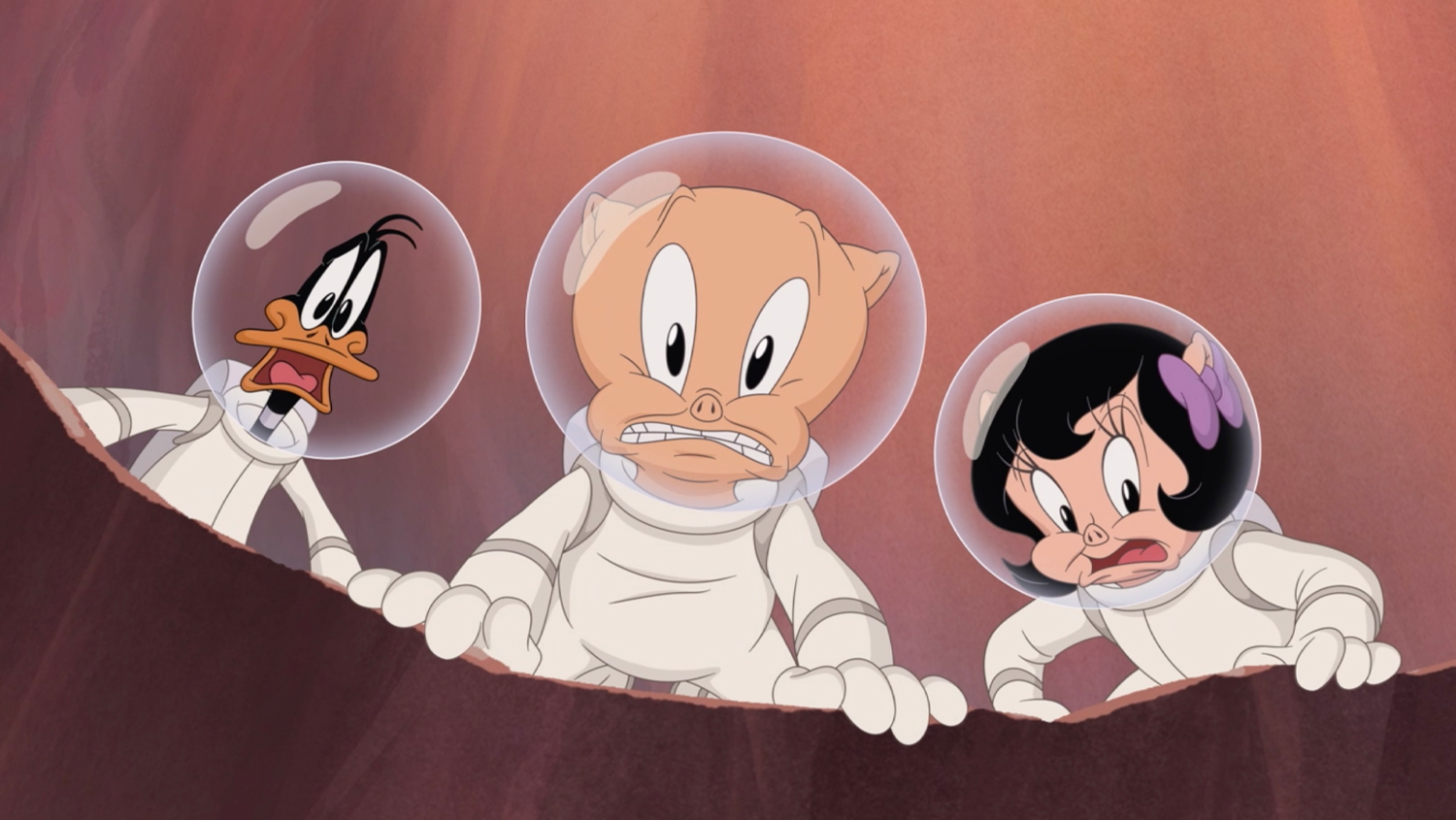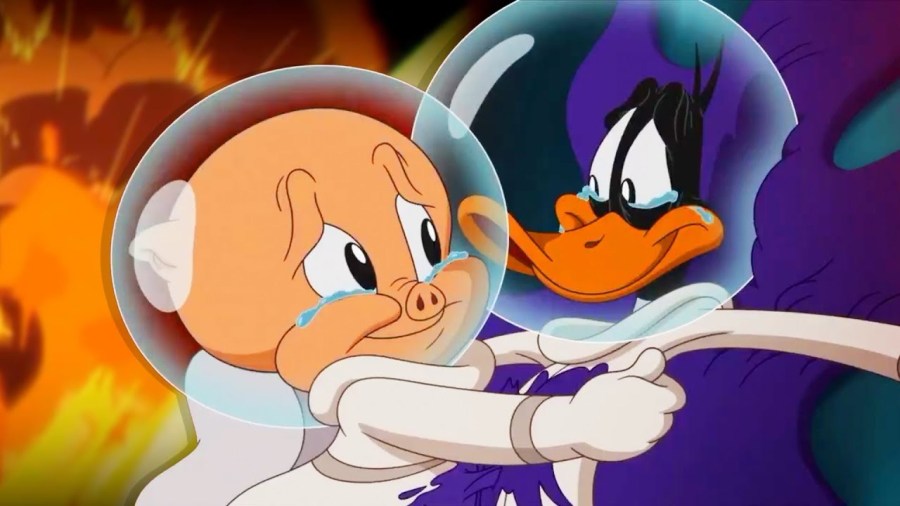Director Pete Browngardt brings the Looney Tunes back to cinemas with a B-movie plot married with two iconic characters.
By Danny Munso
In 2017, during a meeting with Warner Bros. Animation, Pete Browngardt threw out an idea to the execs. He wanted to direct a Looney Tunes short. Warner Bros. liked the idea of new shorts for their classic characters like Bugs Bunny, Daffy Duck, Porky Pig and the rest so they took Browngardt up on his idea, allowing him to oversee over 80 shorts that aired on Max between 2020-2024. As his time on the series was winding down, the studio approached Browngardt about pitching an idea for a feature film. He returned with The Day the Earth Blew Up: A Looney Tunes Movie that features Daffy and Porky starring in an homage to sci-fi B-movies of the 1950’s. The film almost fell victim to the corporate overlords of WB (recall the Coyote vs. Acme saga earlier this year) but will be released in February thanks to Ketchup Entertainment, which is also releasing the film in December for an awards-qualifying run. Ahead of that, Browngardt sat down with Backstory to discuss the film.
BACKSTORY: After you were approached about doing a film, did you start with the idea of doing a Porky and Daffy film or did you start with the B-movie plot?
Pete Browngardt: We knew we wanted to use Porky and Daffy first and then I knew early on that I wanted it to be a genre picture in the sense that they have a history of that as a duo. They play a lot of parts. Some of the major Looney Tunes, you can throw them in any sort of part. Daffy has played Gary Cooper. He has played a Dick Tracy-type of character. I knew I wanted to do a genre thing to kind of frame it and also that does a lot for you story-wise and writing-wise to put yourself into this is the genre we’re working in. What are the tropes we want to play with? What can we parody? What can we satire? How can we make this a Looney Tunes one? Also we wanted Porky and Daffy early because they’re not the only Looney Tunes characters that don’t want to eat each other or kill each other but they’re probably the most famous. They’re buddies and you can do a relationship comedy with them.
The characters are so inherently funny and these cartoons lend themselves to comedy so easily but was it tricky to find the emotional core of the story between the two characters?
That was probably the hardest part of making the film, other than how low the budget was. So getting the quality up was very challenging to and a lot of work went into making it look as polished and as expensive and polished as possible with our budget. But yeah the emotional thing was probably what we did the most passes on story-wise to try and solve. To be honest with you, we wrote and boarded the movie. We wrote a script and then re-wrote it 4-6 times with different animatics. Storyboarding is about re-boarding. That’s what they tell you in animation school and it really is. You want to try things and you want to blue sky it at the start when anything is possible and then carve it down and sculpt it down into something. The emotional thing was challenging. We wanted Petunia to play a role but we didn’t want that to be the focus of it. We wanted it to be about them and their history together and their yin/yang personalities causing the issue with the end of the world at stake.

During the multiple animatics you were obviously tracking the emotional storyline but were there other big story changes going on as well?
We had a whole sequence in Area 51 that we cut that was very, very funny. They met Elvis there and there was a whole Elvis substory. It was really funny. It was killer because getting something that’s funny is very hard. Being funny is very hard. I think John Carpenter said making a horror movie is fun to make but making a comedy is horrible to make because it’s hard to go, I’m funny, look at me. We were after the emotional story. We were always tracking that through the writing process and the boarding process and making sure that we were finding the right amount. You’re getting the studio’s feedback and they’re pushing it in that direction because they need it to have that sophistication of that emotion and I agreed and that’s how I pitched the film.
Kevin Costello wrote the first draft of the script but you took the extra step of making sure all of the story artists got credit as writers on the project, which is very rare in animation. (The final writing credits on the film are awarded to Browngardt, Costello, Darrick Bachman, Andrew Dickman, David Gemmill, Alex Kirwan, Ryan Kramer, Jason Reicher, Michael Ruocco, Johnny Ryan and Eddie Trigueros.) How difficult was that to achieve?
Very hard. Very hard. It’s something I’ve fought for on all my productions. The only other person I’ve seen do it was Stephen Hillenberg on the original (2004) SpongeBob movie. He did get that and that was to be honest huge because having that precedent of saying they did it, why can’t we do it was important. When you have that sort of leverage in a sense when you’re talking to the studio or the people making these decisions, it puts them into a little bit of a corner. The story artist is the unsung hero of the animation process. It’s probably in my opinion, I’m from story. I came from the story side of things. There’s so much rewriting and rarely, even when the director writes the script like Brad Bird or Andrew Stanton, the film changes so drastically to the final product always in animation. It’s not like a Coen Brothers film or a Wes Anderson film where you read the script and that’s pretty much the movie word for word and shot for shot. Animation is redone and redone and tested and board artists have to work on sequence for months to try and keep a fresh take on things. It’s probably one of my proudest things about the film is I got them those credits. We had a first draft from Kevin Costello and it helped sell the film and get it greenlit and what more can you ask from a script? And there are some great moments from that original script that still made it through the final process. I love how collaborative animation is. As much as I which I was some sort of auteur, I just love finding people who I’m a fan of their work and get to learn from them and work with them and come together on a project and create something out of nothing. It’s a special thing and animation has a great camaraderie with each other.

This film uses a lot of various animation styles in different sequences. There’s even a short film in the first act—that sees Daffy and Porky fired from various jobs—where you change the aspect ratio to that of the old shorts. What inspired those choices?
That’s my film nerd stuff. Actually, the short thing was very early and one of my earliest ideas. I wanted to put a short within the film and that was a little inspired by one my favorite films, Who Framed Roger Rabbit, where they open with a short film. I thought it was a good idea and I was proud of how we pulled it off. The style thing, if you really think about it, there were 40 years of classic Looney Tunes and the styles go all over the place and evolve. Even the character stylings change depending on which artist drew them. They never had a set style so I thought we should play with style. It also does a lot of work for you entertainment-wise because then the audience doesn’t know what to expect next.
With your work on Looney Tunes done, what are you working on next?
I can’t say specifically what but I’m working on a project with Aardman Animation. It’s very exciting. I’ve been working on that since September and I’m very happy. Incredible company with incredible history and it’s an honor to be affiliated with such a great studio.
If you’d like to subscribe, feel free to use coupon code: SAVE5 to take $5 off your subscription and get instant access!
All you need to do is click here to subscribe!
There’s plenty more to explore in Backstory Magazine issue 54 you can see our table of contents right here.
Thanks as always for spreading the word and your support!